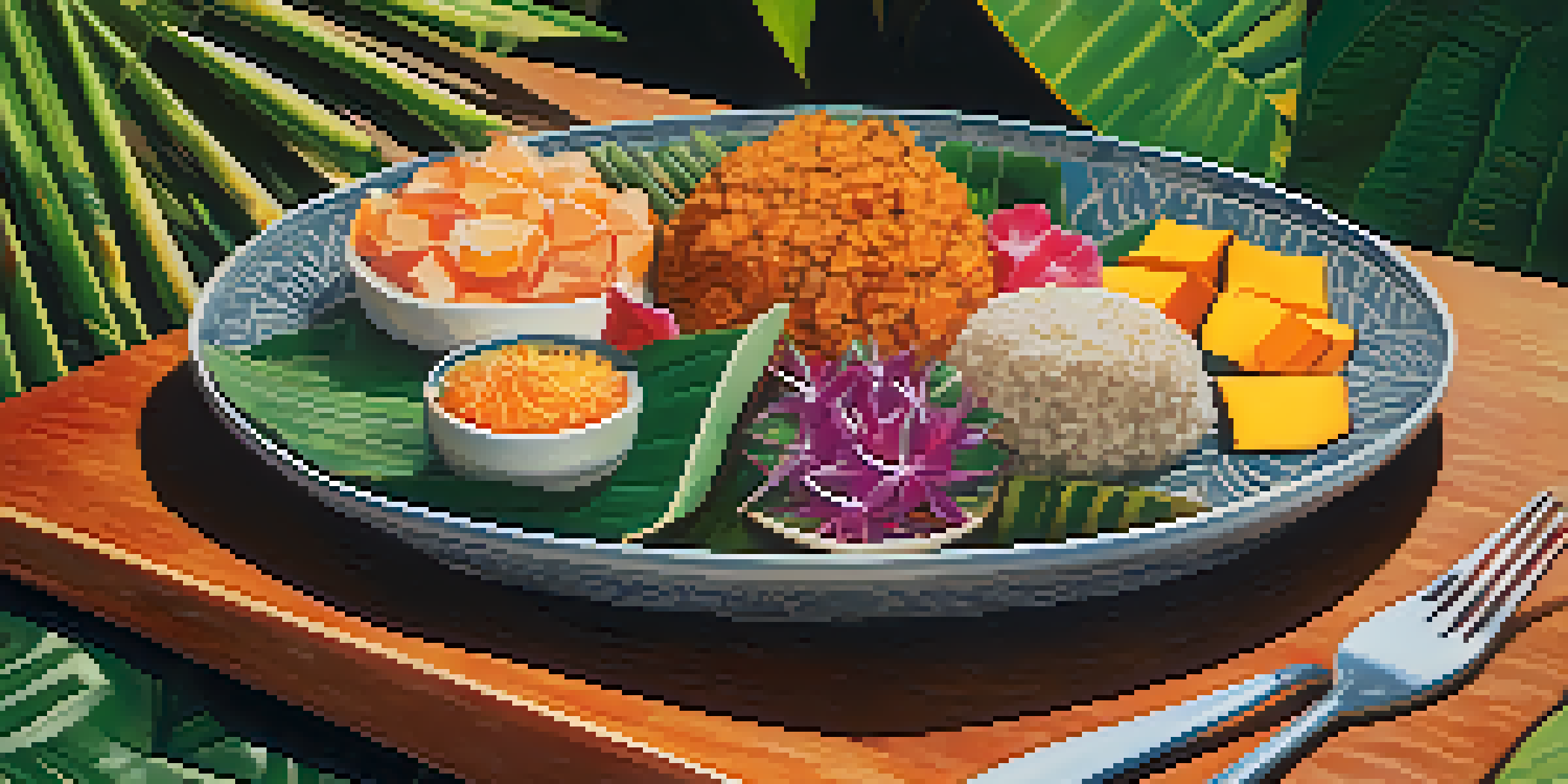Local Flavors: The Role of Indigenous Ingredients in Hawaii

Understanding Indigenous Ingredients in Hawaii
Indigenous ingredients play a crucial role in Hawaiian cuisine, reflecting the islands' rich cultural heritage. These native foods, such as taro, sweet potatoes, and fish, have been cultivated and cherished for centuries. They not only nourish the body but also tell stories of the land and its people, forming a deep connection between the two.
Food is an important part of a balanced diet.
In Hawaii, food is more than sustenance; it’s a way to honor traditions and celebrate community. The use of indigenous ingredients emphasizes sustainability and respect for nature, as many of these foods are grown locally. This practice not only supports the local economy but also fosters a sense of pride among residents.
Moreover, incorporating indigenous ingredients into modern recipes can enhance the culinary landscape. Chefs and home cooks alike are exploring these flavors, creating innovative dishes that celebrate Hawaii's unique identity. By embracing these ingredients, we preserve the history and culture that have shaped the islands’ cuisine.
Taro: The Heart of Hawaiian Cuisine
Taro, known as kalo in Hawaiian, is often regarded as the cornerstone of traditional Hawaiian diets. This versatile root vegetable has been cultivated in Hawaii for over a thousand years and serves as a staple in many local dishes. From poi, a popular dish made from pounded taro, to taro chips, its unique flavor and texture make it an integral part of the culinary scene.

Beyond its delicious taste, taro carries significant cultural meaning. It’s believed to be an ancestor of the Hawaiian people, symbolizing the deep connection between the land and its inhabitants. Celebrating taro in dishes not only highlights its nutritional benefits but also honors the traditions of the past.
Indigenous Ingredients Enhance Cuisine
Hawaiian cuisine utilizes native ingredients like taro and fish to celebrate cultural heritage and promote sustainability.
The growing interest in farm-to-table dining has led to a revival of taro cultivation, encouraging local farmers to grow this beloved crop. As more chefs incorporate taro into their menus, we see a resurgence of traditional recipes alongside modern culinary creations, bridging the gap between history and innovation.
Fish: A Cultural and Culinary Staple
Fish has always been a fundamental part of Hawaiian life, thanks to the surrounding Pacific Ocean teeming with marine life. Traditional fishing practices, such as using fish traps and nets, have been passed down through generations, showcasing the importance of sustainability. Fish not only provides nourishment but also serves as a way to connect with the ocean and the community.
Cooking is like love. It should be entered into with abandon or not at all.
Popular local fish varieties, like ono and mahi-mahi, are often featured in traditional dishes such as poke. This dish, made with fresh diced fish and seasonings, highlights the flavors of the ocean while remaining simple and wholesome. The emphasis on freshness and quality reflects the respect Hawaiians have for their natural resources.
Today, many chefs are creatively reinterpreting traditional fish dishes to appeal to modern palates. By incorporating indigenous fish into contemporary recipes, they keep the culinary heritage alive while adapting to new tastes. This fusion of old and new not only preserves tradition but also showcases the vibrant flavors of Hawaii.
Sweet Potatoes: A Nutritious Powerhouse
Sweet potatoes, or 'uala,' are another indigenous ingredient that holds a prominent place in Hawaiian cuisine. Known for their vibrant color and natural sweetness, they are packed with nutrients and can be prepared in various ways. From roasted to mashed, sweet potatoes add depth and flavor to many traditional dishes.
Historically, sweet potatoes were a vital food source for early Hawaiian settlers, providing essential sustenance. Their adaptability to the local climate made them a staple crop, and they remain beloved today. The cultivation of sweet potatoes also reflects the agricultural practices that respect the land and its resources.
Taro: A Cultural Staple in Hawaii
Taro, or kalo, is a vital ingredient in Hawaiian diets, symbolizing the deep connection between the land and its people.
As more people seek healthier eating options, sweet potatoes have found their way into modern recipes, from salads to desserts. Their versatility allows chefs to experiment while honoring traditional Hawaiian flavors. By incorporating sweet potatoes into contemporary dishes, we celebrate not only their taste but also their historical significance.
Herbs and Spices: Enhancing Flavor Profiles
Hawaiian cuisine is not just about the main ingredients; herbs and spices also play a vital role in flavoring dishes. Indigenous herbs, such as ʻawa (kava) and ʻōlena (turmeric), have been used for centuries, both for their culinary and medicinal properties. These ingredients add depth and complexity, enhancing the overall flavor profiles of traditional recipes.
Incorporating indigenous herbs into dishes is a beautiful way to celebrate Hawaii's biodiversity. Many chefs are experimenting with these flavors, creating unique blends that reflect the spirit of the islands. The use of local herbs often results in a more vibrant and fresh taste, elevating the dining experience.
As the farm-to-table movement continues to grow, the demand for locally sourced herbs is on the rise. This trend not only supports local farmers but also encourages chefs to innovate and create dishes that showcase indigenous flavors. The result is a delicious fusion of tradition and modernity that highlights the best of Hawaiian cuisine.
The Role of Sustainability in Indigenous Cooking
Sustainability is at the heart of utilizing indigenous ingredients in Hawaiian cuisine. Traditional practices emphasize respecting the land and harvesting resources in a way that preserves them for future generations. This philosophy is reflected in the culinary world, where chefs prioritize local and seasonal ingredients to minimize their environmental impact.
By sourcing indigenous ingredients, chefs support local farmers and promote economic growth within the community. This commitment to sustainability not only enhances the quality of the food but also fosters a sense of responsibility towards the environment. It creates a culinary landscape that values both flavor and ecological stewardship.
Sustainability Shapes Culinary Practices
Chefs in Hawaii prioritize local sourcing and sustainable practices, ensuring a balance between tradition and environmental stewardship.
As diners become more conscious of their food choices, the demand for sustainable practices continues to rise. Restaurants that focus on indigenous ingredients and sustainable sourcing are not only appealing to eco-conscious customers but also paving the way for a more responsible food industry in Hawaii. This shift towards sustainability enriches the culinary experience while honoring the islands' rich heritage.
Creating a Culinary Experience: Beyond the Plate
Dining in Hawaii is an experience that goes beyond just the food on the plate; it's about the stories and traditions behind each dish. When chefs incorporate indigenous ingredients, they invite diners to connect with the culture and history of the islands. This storytelling aspect enhances the overall dining experience, making it memorable and meaningful.
Many restaurants in Hawaii are embracing this philosophy by offering tasting menus that highlight indigenous ingredients and their stories. Diners can explore the rich flavors of the islands while learning about the significance of each ingredient. This immersive approach to dining fosters a deeper appreciation for Hawaiian culture and culinary artistry.

As the culinary scene in Hawaii continues to evolve, the incorporation of indigenous ingredients will remain a focal point. By celebrating these flavors and their cultural significance, chefs create a unique experience that resonates with both locals and visitors. This commitment to storytelling through food strengthens the bond between the community and its culinary heritage.
The Future of Indigenous Ingredients in Hawaii
As we look to the future, the role of indigenous ingredients in Hawaii's culinary landscape is poised to grow even more significant. With a renewed focus on sustainability and local sourcing, chefs and home cooks alike are eager to explore traditional flavors while adapting them for modern tastes. This evolution ensures that the rich history of Hawaiian cuisine continues to thrive.
Educational initiatives and programs are also playing a vital role in preserving knowledge about indigenous ingredients. By raising awareness about their importance, these efforts encourage the next generation to appreciate and utilize local foods. This connection to the past empowers individuals to embrace their cultural heritage through cooking.
Ultimately, the future of Hawaiian cuisine lies in the balance between tradition and innovation. As chefs continue to experiment with indigenous ingredients, they’ll create exciting new dishes that honor the islands’ rich culinary history. This blend of old and new ensures that Hawaii’s culinary identity remains vibrant and relevant for years to come.